2. 上海水产品加工及贮藏工程技术研究中心 上海 201306;
3. 农业农村部水产品贮藏保鲜质量安全风险评估实验室 上海 201306
2. Shanghai Engineering Research Center of Aquatic-Product Processing & Preservation, Shanghai 201306, China;
3. Laboratory of Quality and Safety Risk Assessment for Aquatic Products on Storage and Preservation, Ministry of Agriculture and Rural Affairs, Shanghai 201306, China
中华绒螯蟹(Eriocheir sinensis)是我国重要的淡水养殖产品,因其独特的风味和较高的营养价值而受到消费者的青睐,具有很高的经济价值(邵洋等, 2021)。据统计,我国中华绒螯蟹的产量逐年提升,2020年养殖中华绒螯蟹的产量已达到77.6万t (农业农村部渔业渔政管理局等, 2017—2021)。中华绒螯蟹以活品销售为主,其产区主要分布在我国的东部地区,因此,活蟹需要经过不同距离的运输才能销售到全国乃至世界各地。近年来,随着互联网和电商经济的快速发展,越来越多的中华绒螯蟹产品销售从线下转移到线上,电商销售逐渐占据主导地位(戴红君等, 2021)。
鲜活甲壳类水产品的运输是一个相对复杂的过程,需要控制潜在的运输刺激,减轻动物的生理应激反应,从而提高存活率,还应关注如何延长运输时间、减少成本,同时保障安全性和高品质(肖童等, 2022)。由于中华绒螯蟹具有较长时间的离水存活能力,因此,电商运输主要采用干露运输的方式。但由于地理位置的差异导致运输时间的不同,电商销售模式的运输时间一般在24~72 h。为保证长时间运输的存活率和品质,电商模式运输中华绒螯蟹时均是用泡沫箱作为容器来减少震动,冰袋或冰瓶作为降温介质来降低运输过程中蟹所处环境的温度,使其新陈代谢减弱,处于半休眠或完全休眠的状态(倪康达等, 2021; 聂小宝等, 2012),从而降低运输过程中氧气、应激胁迫等因素对它们的负面影响(肖童等, 2022),但经过运输到达消费者手中的中华绒螯蟹仍存在死亡、活力下降和风味不佳等情况。近年来,鲜活甲壳类水产品在贮运流通过程中的品质变化引起了学术界的关注(Guan et al, 2020; Lorentzen et al, 2018、2020)。中华绒螯蟹的电商贮运流通模式高度发达,对于其在活体物流运输过程中的生化特性和风味特性的变化亟需明确。
因此,本研究通过模拟电商运输条件,探究雌性中华绒螯蟹在模拟快递运输过程中活力以及蟹肉生化特性和滋味品质的变化,同时对活力、生化特性和滋味品质进行相关性分析,以期为销售运输过程中中华绒螯蟹的品质变化提供参考,并为后续运输方法的优化及品质调控研究提供理论依据。
1 材料与方法 1.1 实验材料与模拟快递运输设计雌性中华绒螯蟹于2021年11月采自上海崇明区崇东养殖基地,平均体重为(150.3±8.8) g,活力较好,用棉线扎紧后置于底部铺冰的泡沫箱内,并在2 h内运回实验室。
模拟快递运输设计参考倪康达等(2021)稍加改动,中华绒螯蟹到达实验室后,室温暂养24 h。随机挑选90只雌蟹,用同等规格绳索捆扎雌蟹后,放入规格为33 cm×17 cm×22 cm的泡沫箱中,每个泡沫箱放置10只。其中,在每个泡沫箱底部放一个250 g的冰袋,随后以背上腹下的姿态放置2层蟹,每层5只,并在两层蟹中间放置一个温湿度记录仪,最后在最上层蟹背上再放置一个250 g的冰袋。装箱后盖上盖子,用胶带缠绕盖子与箱体连接处一圈。将装箱打包好的9个箱子置于模拟汽车运输振动台上(转速为100 r/min),周边放置一个温度记录仪,记录室温。温湿度记录仪设置每3 min自动记录一次箱内的温度和湿度。同时,在模拟运输前挑选30只蟹作为对照组(0 h)。
本实验设置0、24、48和72 h共4个时间梯度,每个时间梯度3个重复。当各贮运时间结束时,先进行活力评价,随后选取活蟹解剖,取出蟹肉并放入塑封袋中,放置于–40 ℃冰箱待用。
1.2 仪器与设备RC-4HC温湿度记录仪(江苏精创电气股份有限公司);SSMNT-300VTR模拟汽车运输振动台(上海松式实验设备制造有限公司);FiveEasy Plus pH计,(Mettler Toledo);UV-1800PC紫外可见分光光度计(上海美普达公司);Kjeltec 8400全自动凯氏定氮仪(FOSS,丹麦);Soxtec索氏抽提仪(FOSS,丹麦);SXL-1002马弗炉(上海精宏);L-8800氨基酸全自动分析仪(Hitachi,日本);W2690/5高效液相色谱仪(Waters,美国)。
1.3 实验方法 1.3.1 活力评价与死亡判断建立10人评分小组,正式实验前对该10人进行中华绒螯蟹活力与死亡判断的培训。正式实验评分小组按表 1的标准对中华绒螯蟹的活力进行评价,并以0级活力作为蟹死亡判断标准。
|
|
表 1 中华绒螯蟹的活力评价标准(倪康达等, 2021; Fotedar et al, 2011) Tab.1 The standard of vigor state evaluation of E. sinensis (Ni et al, 2021; Fotedar et al, 2011) |
乳酸:采用南京建成生物工程研究所的试剂盒进行测定,单位为mmol/g(蛋白)。
pH测定:结合杨丰等(2020)的方法稍加改动,称取蟹肉2 g (精确到0.01 g),加入18 mL蒸馏水,均质30 s后冷冻离心10 min (5 000 r/min、4 ℃),过滤后取上清液进行pH测定。
TVB-N:全自动凯氏定氮仪进行测定,结果以mg N/100 g湿基计。
1.3.3 基本营养成分测定水分参照GB 5009.3-2016测定;灰分参照GB 5009.4-2016测定;粗蛋白参照GB 5009.5-2016测定;粗脂肪参照GB 5009.6-2016测定。
1.3.4 游离氨基酸的测定参考Fan等(2022)的方法稍加改动,称取蟹肉熟样0.5 g (精确到0.000 1 g)于离心管中,加入15 mL 5%的三氯乙酸溶液,匀浆30 s,重复3次,冰浴条件下超声15 min,在4 ℃冰箱中静置2 h后离心(10 000 r/min, 4 ℃, 10 min),取5 mL上清液,用NaOH溶液调节pH值至2.00±0.02,并定容至10 mL,充分摇匀后,过0.22 μm水相滤膜至进样瓶中。采用全自动氨基酸分析仪测定游离氨基酸并进行分析。
1.3.5 呈味核苷酸的测定参考张艳霞等(2020)的方法稍加改动,称取蟹肉熟样3 g (精确到0.000 1 g)于离心管中,加10 mL 10%的高氯酸溶液,匀浆30 s,重复3次,冰浴条件下超声5 min后离心(10 000 r/min, 15 min,4 ℃),收集上清液存放于4 ℃冰箱中,沉淀继续加入5 mL 5%高氯酸溶液,重复上述操作2次后,合并3次上清液并用KOH溶液调节pH值至5.75± 0.02,于4 ℃冰箱中静置30 min,取上清液定容至50 mL,充分摇匀后,过0.22 μm水相滤膜至进样瓶中后上机测定。
HPLC条件:GL-Inertsil ODS-3色谱柱(250.0 mm × 4.6 mm, 5 μm);柱温为30 ℃;流速为1 mL/min;进样量为10 μL;紫外检测器检测波长为245 nm。流动相A为甲醇,B为pH 5.75的0.02 mol/L磷酸氢二钾与磷酸二氢钾的混合溶液。
1.3.6 滋味活度值及味精当量滋味物质的滋味活度值(taste activity value, TAV)按式(1)计算(郭宏慧等, 2022):
| $\mathrm{TAV}=\frac{c}{T}$ | (1) |
式中,c为滋味物质的绝对含量/(mg/100 g);T为滋味物质的阈值/(mg/100 g)。
味精当量(equivalent umami concentration, EUC)按照式(2)计算(谢辉等, 2021):
| $ {\text{EUC}} = \sum {{a_i}{b_i}} + 1\;218(\sum {{a_i}{b_i}} )(\sum {{a_j}{b_j}} ) $ | (2) |
式中,EUC为味精当量(g MSG/100g)(谷氨酸钠,MSG);ai为鲜味氨基酸[天冬氨酸(Asp)、谷氨酸(Glu)]的含量,g/100g;bi为鲜味氨基酸相对于MSG的相对鲜度系数(其中,Glu为1,Asp为0.077);aj为呈味核苷酸[5′-鸟苷酸(GMP)、5′-肌苷酸(IMP)及5′-腺苷酸(AMP)]的含量,g/100g;bj为呈味核苷酸相对于IMP的相对鲜度系数(其中,IMP为1,GMP为2.3,AMP为0.18);1 218为协同作用系数。
1.3.7 人工感官评价参考Fan等(2022)的方法,挑选7名(3男4女)经验丰富的感官评定人员,对不同模拟运输时间下雌性中华绒螯蟹活蟹熟制蟹肉的鲜味、甜味、咸味、酸味及苦味5个呈味特征进行感官评定。根据GB 12313-1990《感官分析方法风味剖面检验》分6个强度点打分,0=不存在;1=刚好可识别;2=弱;3=中等;4=强;5=很强。
1.4 数据处理每组实验至少3组平行,得到的结果用平均值±标准差(Mean±SD)表示,显著性差异使用单因素方差分析(one-way ANOVA),设置P < 0.05为差异显著性,相关作图应用OriginPro 2021软件。
2 结果与分析 2.1 模拟快递运输过程中贮运箱内外温度及箱内相对湿度的变化由图 1可知,模拟快递运输过程中贮运箱内的温度随着运输时间的延长呈先下降后上升的趋势,可能与贮运箱内放置冰袋有关。前期冰袋的降温作用使箱内温度由16.5 ℃下降至6.9 ℃,但随着模拟运输时间的增加,冰袋的降温作用逐渐不明显,大约12 h后箱内的温度开始逐步升高,30 h左右已达到箱外温度水平,接着持续升高并超过箱外温度,直到模拟运输结束,箱内温度始终高于箱外温度。
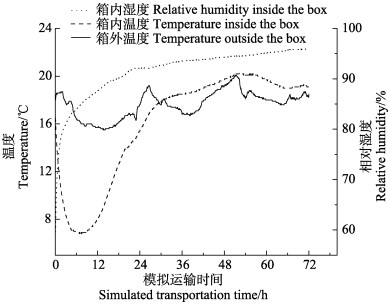
|
图 1 模拟快递运输过程中贮运箱内外温度及箱内相对湿度的变化 Fig.1 Changes of temperature inside and outside the storage box and relative humidity inside the box during simulated express transportation |
箱内的相对湿度随着模拟运输时间的增加而上升,且最终箱内的相对湿度达到96%。郝晨光等(2021)在模拟克氏原螯虾(Procambarus clarkii)空运时同样发现,密封泡沫箱内的相对湿度随着模拟空运时间的延长而上升。推测原因是中华绒螯蟹的呼吸作用产生的水分以及冰袋的蒸发导致箱内相对湿度的上升。
2.2 模拟快递运输对中华绒螯蟹死亡率与活力的影响模拟快递运输过程中中华绒螯蟹死亡率与活力变化见图 2。在本研究中,模拟运输24 h的中华绒螯蟹未见死亡,模拟运输48 h后死亡1只,死亡率为3.33%;模拟运输72 h后死亡12只,死亡率达40.00%,表明随着贮运时间的延长,中华绒螯蟹的死亡率会急剧上升。

|
图 2 模拟快递运输过程中中华绒螯蟹的活力分布 Fig.2 The distribution of vigor state of E. sinensis during simulated express transportation 图中各柱上面标有不同字母表示差异显著(P < 0.05),下同。 Different letters marked above each column in the figure indicate significant differences (P < 0.05), the same below. |
活力评价发现,中华绒螯蟹经过24 h模拟运输后,活力4级的有22只,占73.33%,7只的活力达到3级,占23.33%,1只活力仅到1级。24 h组整体活力与未经模拟运输的0 h组无显著性差异(P > 0.05)。但经过48 h运输后,中华绒螯蟹的整体活力显著下降(P < 0.05),其中,活力达4级和3级的各有9只,均占30.00%,2级的有6只,占20.00%,1级的有5只,占16.67%。经过72 h模拟运输后,活力达4级的仅有2只,占6.67%,3级的有3只,占10.00%,2级和1级的总数达13只,占43.33%,活力低迷。
温度是影响甲壳类动物干露运输过程中存活率的重要因素之一(Barrento et al, 2011)。前期箱内的冰袋使箱内温度维持在较低的水平,因此经过24 h运输后,中华绒螯蟹的活力未显著下降。但随着运输时间延长,冰块逐渐融化,箱内温度随之升高,蟹的代谢也逐渐增强,呼吸作用消耗氧气且会不断往体外排出水分,导致可利用的总溶解氧含量下降(尚海涛等, 2018),中华绒螯蟹同时受到了低氧和高温胁迫,无氧代谢产物和氨氮代谢物等在体内积累,因此模拟运输48 h后中华绒螯蟹活力大幅度减弱,72 h后死亡率激增。相关研究表明,低氧胁迫会影响水生甲壳动物的生长和生理机能,导致抗逆能力下降甚至死亡(Sun et al, 2016、2017),高温会使甲壳动物代谢紊乱,机体免疫力下降(Albalat et al, 2019)。故运输时间越长,越不利于中华绒螯蟹生存,这与倪康达等(2021)的研究结果相似。
2.3 基本营养成分模拟快递运输过程中中华绒螯蟹蟹肉基本营养成分的变化如表 2所示,其中,蟹肉的水分含量随着模拟快递运输时间的延长而下降(P < 0.05),可能是机体水分参与呼吸作用而导致水分含量下降(倪康达等, 2021)。不同实验组之间中华绒螯蟹蟹肉的粗脂肪和灰分均无显著差异(P > 0.05)。中华绒螯蟹蟹肉粗蛋白的含量较高,约占18.65%,而模拟运输48 h组蟹肉的粗蛋白含量显著高于其他3组,约占19.75%。蛋白质除了是供能物质外,还可能具有抗应激的功能(周萌等, 2011)。模拟运输前期,中华绒螯蟹体内可能合成了功能性蛋白质来抵抗应激、维持基础代谢,后期通过分解蛋白质来弥补体内氨基酸的缺乏或提供能量。
|
|
表 2 模拟快递运输过程中中华绒螯蟹蟹肉基本营养成分的变化 Tab.2 Changes of proximate composition in meat of E. sinensis during simulated express transportation/% |
乳酸是甲壳类动物体内无氧代谢的产物之一。在胁迫环境中,生物体对能量需求增大,而自身基础代谢水平降低,对无氧代谢供能依赖增加(段亚飞等, 2016)。因此,乳酸可作为反映胁迫程度的指标(Lorenzo et al, 2021)。中华绒螯蟹在模拟快递运输过程中蟹肉乳酸含量的变化如图 3所示。与0 h组相比,24 h组乳酸含量升高不显著(P > 0.05),48 h组乳酸含量显著升高(P < 0.05)。原因可能是运输前期箱体内的环境温度较低,中华绒螯蟹进入了休眠状态,代谢减缓,乳酸脱氢酶活性减弱,同时,前期箱内可能有一定量的氧气可用于有氧呼吸,因此,乳酸含量增加不显著,根据运输过程中对箱内温度变化的记录,大约30 h后箱内温度达到箱外温度并继续升高超过箱外温度,高温和低氧胁迫增强,蟹的代谢增强,更多的供能来源于糖酵解途径,因此,乳酸含量显著升高。姜娜等(2014)研究发现,不同干露时间处理结束时,三疣梭子蟹肌肉乳酸含量均显著升高,表明无氧代谢水平增加对三疣梭子蟹适应干露胁迫环境具有重要作用。Hagerman等(1979)认为甲壳动物无氧代谢积累的终产物主要是乳酸,乳酸供能效低,要维持正常的生理活动必须消耗大量的丙酮酸转化为乳酸放能。长期处于应激状态下的中华绒螯蟹为维持供能以及机体血糖的稳定,肌肉中的乳酸也被循环系统代谢(Daskalova, 2019),因此,72 h组的乳酸含量下降。
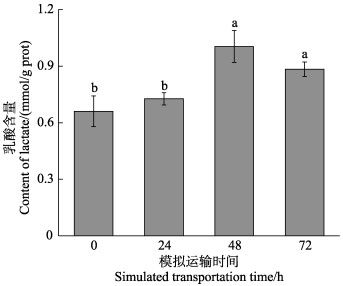
|
图 3 模拟快递运输过程中中华绒螯蟹蟹肉乳酸含量的变化 Fig.3 Changes of lactate content in meat of E. sinensis during simulated express transportation |
中华绒螯蟹在模拟快递运输过程中蟹肉TVB-N的变化如图 4所示,随着模拟运输时间的增加,蟹肉TVB-N的积累量不断增加。初始的TVB-N水平为5.23 mg N/100 g;经过48 h模拟运输后,TVB-N含量显著增加至7.88 mg N/100 g;72 h后,大幅增长至11.66 mg N/100 g (P < 0.05)。根据GB2733-2015的规定,水产品TVB-N含量超过25 mg N/100 g为不可接受,而完成72 h模拟运输的中华绒螯蟹蟹肉
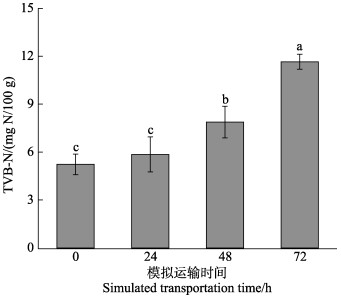
|
图 4 模拟快递运输过程中中华绒螯蟹蟹肉TVB-N的变化 Fig.4 Changes of TVB-N in meat of E. sinensis during simulated express transportation |
TVB-N含量远低于该值。南方帝王蟹暴露于空气中24 h后肌肉的TVB-N含量同样显著增加(Lorenzo et al, 2021)。多数甲壳类动物为排氨型生物,其排泄的氨氮主要由蛋白质和氨基酸分解形成,排泄氨氮的器官主要为鳃(Weihrauch, 2004)。然而,在离水状态下,鳃丝彼此簇集阻碍了鳃组织与外界环境间的气体和离子交换,导致代谢物在体内积累(路允良, 2015)。
2.4.3 pHpH的变化受到不同代谢产物共同的影响,中华绒螯蟹在模拟快递运输过程中蟹肉pH的变化如图 5所示。在模拟快递运输过程中,中华绒螯蟹蟹肉的pH在6.5~6.8之间波动,总体呈升高的趋势。虽然在模拟运输过程中,中华绒螯蟹蟹肉乳酸含量增加,但pH却是呈升高的趋势,可能是较长的运输时间和较高的温度导致蛋白酶活性较高,从而导致蟹肉中碱性含氮化合物的含量较高(Lorentzen et al, 2018)。在离水贮藏的前期,锯缘青蟹(Scylla serrata)肌肉的pH也呈升高的趋势(Waritchon, 2008)。
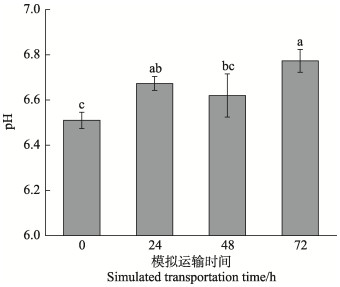
|
图 5 模拟快递运输过程中中华绒螯蟹蟹肉pH的变化 Fig.5 Changes of pH in meat of E. sinensis during simulated express transportation |
游离氨基酸(free amino acid, FAA)是甲壳类水产品的主要呈味物质之一,主要呈鲜、甜、苦味(Hang et al, 2015; Wang et al, 2018)。模拟快递运输过程中中华绒螯蟹的蟹肉FAAs含量变化如表 3所示,中华绒螯蟹蟹肉中共检测出17种氨基酸,其中,甜味氨基酸含量最高,约占总游离氨基酸的89%,其次是苦味氨基酸和鲜味氨基酸,约占8%和2%。模拟运输24 h后,总游离氨基酸含量从2 526.41 mg/100 g显著下降至1 001.54 mg/100 g (P < 0.05),48 h后总游离氨基酸含量上升至1 453.13 mg/100 g (P < 0.05),72 h后上升至2535.85 mg/100 g,与0 h组无显著性差异(P > 0.05)。鲜、甜、苦味氨基酸在模拟运输过程中同样呈先下降后上升的趋势。温度是影响机体能源物质水平的重要因子之一,甲壳动物在不同温度水平下对参与代谢的能源物质具有不同的偏好(Garcia-Guerrero et al, 2003)。推测运输前期箱内温度较低,中华绒螯蟹在适应低温的过程中消耗了游离氨基酸或部分游离氨基酸参与了功能性蛋白的合成来维持基础代谢(周萌等, 2011)。
|
|
表 3 模拟快递运输过程中中华绒螯蟹蟹肉游离氨基酸的变化 Tab.3 Changes of free amino acids in meat of E. sinensis during simulated express transportation/(mg/100 g) |
表 4为模拟快递运输过程中中华绒螯蟹蟹肉游离氨基酸TAV值的变化。当TAV值大于1时,观察到对整体滋味有较大贡献的主要味觉活性FAAs是谷氨酸、甘氨酸、丙氨酸、精氨酸和组氨酸。0 h组鲜味的FAAs对口感的贡献值为6%,经过模拟运输后下降至3%。其中,0 h组谷氨酸的TAV值>1,而经历模拟运输组的谷氨酸含量大幅下降至TAV值均 < 1,锯缘青蟹在离水贮藏期间也发生蟹肉谷氨酸含量大幅下降的情况(Chiou et al, 2004)。谷氨酸为鲜味氨基酸且鲜味较强,并与次黄嘌呤核苷酸一起产生协同作用可增强鲜味强度(张艳霞等, 2020)。
|
|
表 4 模拟快递运输过程中中华绒螯蟹的蟹肉游离氨基酸滋味活度值的变化 Tab.4 Changes of threshold and TAV of free amino acids in meat of E. sinensis during simulated express transportation |
水产品体内的核苷酸具有多种生理功能,同时也赋予水产品良好的鲜味特征。此外,Yamaguchi等(1971)还发现,呈味核苷酸和鲜味氨基酸之间存在可以增强鲜味的协同作用。5′-鸟苷酸(GMP)、5′-肌苷酸(IMP)和5′-腺苷酸(AMP)是中华绒螯蟹蟹肉中主要的呈味核苷酸(谢辉等, 2021),其中,IMP和AMP可以通过ATP分解产生。在生物体内的核苷酸代谢中,IMP有两种转化方式:一部分转变成ATP,为细胞提供能量;另一部分可以进一步分解为AMP和GMP,为DNA的合成提供物质基础(步营等, 2021)。
中华绒螯蟹蟹肉核苷酸、EUC和TAV的变化如表 5所示。随着模拟快递运输时间的增加,AMP含量无显著变化;IMP含量在模拟运输前期无显著变化,但经过72 h模拟运输后IMP含量显著增加(P < 0.05);GMP含量在模拟运输72 h后骤降至最低(P < 0.05)。可能是运输后期低氧和高温胁迫不断增强,中华绒螯蟹为抵抗环境胁迫,消耗的ATP较多,而IMP降解速度较慢,造成IMP的积累和GMP的减少。
|
|
表 5 模拟快递运输过程中中华绒螯蟹蟹肉呈味核苷酸、TAV及EUC的变化 Tab.5 Changes of taste nucleotides content, TAV and EUC in meat of E. sinensis during simulated express transportation |
如表 5所示,中华绒螯蟹在模拟运输过程中AMP和IMP的TAV均大于1,说明AMP和IMP对中华绒螯蟹蟹肉的鲜甜味有较大的贡献。呈味核苷酸和鲜味氨基酸之间存在增强鲜味的协同作用,可引入EUC来更全面地评价模拟快递运输过程中中华绒螯蟹蟹肉的鲜味变化。EUC表示鲜味氨基酸和呈味核苷酸通过协同所产生的鲜味强度相当于多少浓度的味精所产生的鲜味强度(Wang et al, 2018)。味精的呈味阈值为0.03 g/100 g,结果显示,各组EUC值均高于阈值。但0 h组蟹肉的鲜味强度相当于9.66 g味精产生的鲜味,而经过运输后EUC值大幅下降,24 h、48 h、72 h组分别相当于1.82 g、2.41 g、4.78 g味精所产生的鲜味。呈味核苷酸的结果表明,当前的运输模式不利于中华绒螯蟹核苷酸类呈味物质的积累。
2.5.3 感官评价图 6为不同模拟运输时间下雌性中华绒螯蟹蟹肉的滋味感官雷达图。鲜味、甜味和咸味都是0 h组的最强,其中,鲜味评分从3.89 (0 h组),下降至3.19 (24 h组)、3.37 (48 h组)、3.59 (72 h组),与游离氨基酸中总鲜味氨基酸的含量在24 h时显著下降、72 h又显著上升以及EUC值先下降后上升的趋势基本一致。各组的酸味和苦味评分均在0~1之间且无差异。鲜味是中华绒螯蟹重要的滋味感官品质(彭静文等, 2019),而感官结果表明,当前的运输模式使蟹肉的鲜味强度降低,从而影响其滋味感官品质。

|
图 6 不同模拟运输时间的中华绒螯蟹蟹肉滋味感官雷达图 Fig.6 Taste sensory evaluation radar map of meat of E. sinensis at different simulated transportation times |
基于以上结果,对模拟快递运输过程中雌性中华绒螯蟹的活力、生化特性和滋味品质进行相关性分析,图 7为相关性热图,其中,滋味品质以TAV值大于1为筛选条件进行分析。活力与生化特性和滋味品质的相关性表明,中华绒螯蟹的活力与蟹肉水分含量呈显著正相关(R=0.68),与TVB-N呈显著负相关(R= –0.66),与IMP呈极显著负相关(R= –0.76)。由以上结果可得,中华绒螯蟹的活力与部分蟹肉生化指标有显著相关性,说明可以通过这些指标,如水分含量、TVB-N等来判断蟹的活力状况。此外,蟹的活力与蟹肉水分含量呈显著正相关也表明运输过程中适当增加环境湿度可能有利于保持蟹的活力。
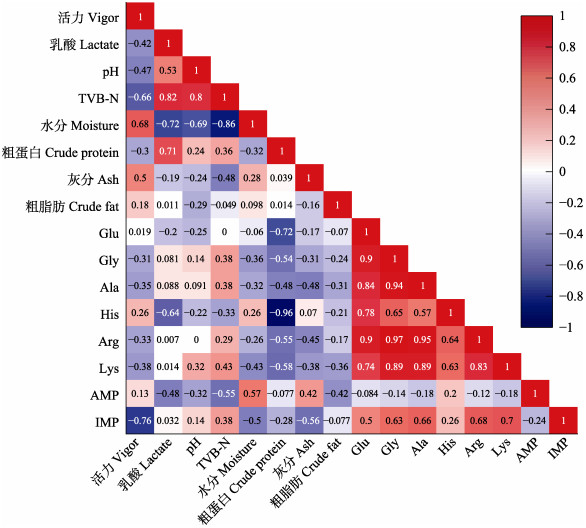
|
图 7 不同模拟运输时间的中华绒螯蟹活力、生化特性和滋味品质的相关性热图 Fig.7 Heat map of correlation between vigor, biochemical characteristics and taste quality of E. sinensis at different simulated transport times |
通过模拟快递运输实验,发现雌性中华绒螯蟹在24 h模拟运输下,无死亡个体且活力强劲,蟹肉基本营养成分、乳酸和TVB-N等无显著变化,且24 h组蟹肉的苦味氨基酸含量最低,印证了活蟹当日送达的重要性。超过24 h后,中华绒螯蟹的活力显著下降,其蟹肉乳酸、TVB-N及pH显著升高,水分含量显著下降。当前运输模式对中华绒螯蟹蟹肉的滋味品质也有较大影响:随着模拟运输时间的增加,鲜味、甜味、苦味游离氨基酸含量呈先下降后上升的趋势;模拟运输72 h后,IMP含量显著增加,GMP含量骤降至最低;经过模拟运输后,EUC值大幅下降且随着运输时间的增加呈先下降后上升的趋势;感官结果也表明,经过模拟运输后蟹肉的鲜味强度降低。
综上所述,随着运输时间的延长,雌性中华绒螯蟹的死亡率显著上升,活力显著下降,生化特性和滋味品质发生显著改变。后续可以探究运输过程中中华绒螯蟹品质变化的机理,同时优化运输条件,降低运输对中华绒螯蟹品质的负面影响。本研究可为销售运输过程中中华绒螯蟹的品质变化提供参考,同时为后续运输条件优化及品质调控等研究与实践提供理论依据。
ALBALAT A, JOHNSON L, COATES C J, et al. The effect of temperature on the physiological condition and immune-capacity of European lobsters (Homarus gammarus) during long-term starvation. Frontiers in Marine Science, 2019, 6: 281 DOI:10.3389/fmars.2019.00281 |
BARRENTO S, MARQUES A, VAZ-PIRES P, et al. Cancer pagurus (Linnaeus, 1758) physiological responses to simulated live transport: Influence of temperature, air exposure and AQUI-S ®. Journal of Thermal Biology, 2011, 36: 128-137 DOI:10.1016/j.jtherbio.2010.12.006 |
BU Y, WANG F, ZHU W H, et al. Taste changes of pearl gentian grouper in waterless keep alive process. Journal of Food Science and Technology, 2021, 39(3): 43-51 [步营, 王飞, 朱文慧, 等. 珍珠龙胆石斑鱼无水保活过程中滋味变化规律研究. 食品科学技术学报, 2021, 39(3): 43-51] |
Bureau of Fisheries, Ministry of Agriculture and Rural Affairs, National Fisheries Technology Extension Center, China Society of Fisheries. China fishery statistical yearbook. Beijing: China Agriculture Press, 2017-2021 [农业农村部渔业渔政管理局, 全国水产技术推广总站, 中国水产学会. 中国渔业统计年鉴. 北京: 中国农业出版社, 2017-2021]
|
CHIOU T K, HUANG J P. Biochemical changes in the abdominal muscle of mud crab Scylla serrata during storage. Fisheries Science, 2004, 70(1): 167-173 DOI:10.1111/j.1444-2906.2003.00785.x |
DAI H J, SUN Y W, REN N, et al. Investigation of Chinese hairy crab industry and analysis of development strategies. Jiangsu Agricultural Sciences, 2021, 49(18): 248-252 [戴红君, 孙艺伟, 任妮, 等. 我国中华绒螯蟹产业现状调查及发展对策分析. 江苏农业科学, 2021, 49(18): 248-252] |
DASKALOVA A. Farmed fish welfare: Stress, post-mortem muscle metabolism, and stress-related meat quality changes. International Aquatic Research, 2019, 11(2): 113-124 DOI:10.1007/s40071-019-0230-0 |
DUAN Y F, DONG H B, WANG Y, et al. Respiratory metabolic enzyme activities and RNA/DNA ratio of Marsupenaeus japonicus after desiccation. Marine Fisheries, 2016, 38(1): 42-50 [段亚飞, 董宏标, 王芸, 等. 干露胁迫对日本囊对虾呼吸代谢酶活性和RNA/DNA比值的影响. 海洋渔业, 2016, 38(1): 42-50 DOI:10.3969/j.issn.1004-2490.2016.01.006] |
FAN L C, XIAO T, XIAN C N, et al. Effect of short-term frozen storage on taste of gonads of female Eriocheir sinensis and the classification of taste quality combined with sensory evaluation and fuzzy logic model. Food Chemistry, 2022, 378: 132105 DOI:10.1016/j.foodchem.2022.132105 |
FOTEDAR S, EVANS L. Health management during handling and live transport of crustaceans: A review. Journal of Invertebrate Pathology, 2011, 106(1): 143-152 DOI:10.1016/j.jip.2010.09.011 |
GARCIA-GUERRERO M, VILLARREAL H, RACOTTA I S. Effect of temperature on lipids, proteins, and carbohydrates levels during development from egg extrusion to juvenile stage of Cherax quadricarinatus (Decapoda: Parastacidae). Comparative Biochemistry and Physiology, Part A: Molecular and Integrative Physiology, 2003, 135(1): 147-154 DOI:10.1016/S1095-6433(02)00354-9 |
GUAN W L, NONG W Q, WEI X B, et al. Impacts of a novel live shrimp (Litopenaeus vannamei) water-free transportation strategy on flesh quality: Insights through stress response and oxidation in lipids and proteins. Aquaculture, 2020, 533: 736168 |
GUO H H, YANG F, GAO P, et al. Analysis of flavor compounds of Chinese mitten crabs (Eriocheir sinensis) from different regions. Progress in Fishery Sciences, 2022, 43(2): 215-227 [郭宏慧, 杨方, 高沛, 等. 不同养殖水域中华绒螯蟹滋味差异分析. 渔业科学进展, 2022, 43(2): 215-227] |
HAGERMAN L, UGLOW R F. Heart and scaphognathite activity in the shrimp Palaemonadspersus rathke. Ophelia, 1979, 18(1): 89-96 DOI:10.1080/00785326.1979.10425492 |
HANG S, LIU F. Proteomic analysis of amino acid metabolism differences between wild and cultivated Panax ginseng. Journal of Ginseng Research, 2015, 40(2): 113-120 |
HAO C G, LI J T, ZHANG Z L, et al. Changes in physiological and biochemical indexes of Procambarus clarkii during simulated air transport. Journal of Southern Agriculture, 2021, 52(10): 2896-2903 [郝晨光, 李军涛, 张泽龙, 等. 模拟空运过程中克氏原螯虾生理生化指标的变化规律. 南方农业学报, 2021, 52(10): 2896-2903 DOI:10.3969/j.issn.2095-1191.2021.10.031] |
JIANG N, WANG F, LU Y L, et al. Effects of air-exposure stress on antioxidant capacity and stress response of swimming crab (Portunus trituberculatus). Journal of Fisheries of China, 2014, 38(12): 1996-2004 [姜娜, 王芳, 路允良, 等. 干露对三疣梭子蟹抗氧化和应激能力的影响. 水产学报, 2014, 38(12): 1996-2004] |
LORENTZEN G, LIAN F, SIIKAVUOPIO S I. Quality parameters of processed clusters of red king crab (Paralithodes camtschaticus)-Effects of live holding at 5 and 10℃ up to 92 days without feeding. Food Control, 2018, 95: 142-149 |
LORENTZEN G, LIAN F, SIIKAVUOPIO S I. Live holding of snow crab (Chionoecetes opilio) at 1 and 5℃without feeding – quality of processed clusters. Food Control, 2020, 114: 107221 DOI:10.1016/j.foodcont.2020.107221 |
LORENZO R A, TOMAC A, TAPELLA F, et al. Biochemical and quality parameters of southern king crab meat after transport simulation and re-immersion. Food Control, 2021, 119: 107480 DOI:10.1016/j.foodcont.2020.107480 |
LU Y L. Basic research about effects of temperature on metabolic physiology of swimming crab Portunus trituberculatus. Doctoral Dissertation of Ocean University of China, 2015 [路允良. 温度对三疣梭子蟹(Portunus trituberculatus)代谢生理特征影响的基础研究. 中国海洋大学博士研究生学位论文, 2015]
|
NI K D, LIU Q H, HOU X, et al. Effects of different storage and transportation time on vigor and nutritional quality of hepatopancreas in adult Eriocheir sinensis. Freshwater Fisheries, 2021, 51(3): 60-67 [倪康达, 刘庆华, 侯鑫, 等. 不同贮运时间对中华绒螯蟹成蟹活力和肝胰腺营养品质的影响. 淡水渔业, 2021, 51(3): 60-67] |
NIE X B, ZHANG Y, ZHANG C F, et al. Research advances on alive transport of low temperature of aquatic product. Food Research and Development, 2012, 33(12): 218-223 [聂小宝, 章艳, 张长峰, 等. 水产品低温保活运输研究进展. 食品研究与开发, 2012, 33(12): 218-223] |
PENG J W, ZHOU F, WANG X C. Effects of formula feed hoarding on the taste quality of female Chinese Eriocheir sinensis. Science and Technology of Food Industry, 2019, 40(11): 91-97 [彭静文, 周纷, 王锡昌. 配合饲料囤养对雌性中华绒螯蟹滋味品质的影响. 食品工业科技, 2019, 40(11): 91-97] |
SHANG H T, YU J F, ZHU L, et al. Techniques of keeping swimming crab Portunus trituberculatus alive without water based on survival analysis. Fisheries Science, 2018, 37(1): 73-78 [尚海涛, 俞静芬, 朱麟, 等. 基于生存分析的三疣梭子蟹无水保活技术研究. 水产科学, 2018, 37(1): 73-78] |
SHAO Y, YU D W, YANG F, et al. Comparison of the taste compounds in different grades of Chinese mitten crab (Eriocheir sinensis). Progress in Fishery Sciences, 2021, 42(4): 192-198 [邵洋, 余达威, 杨方, 等. 不同等级中华绒螯蟹滋味物质的比较分析. 渔业科学进展, 2021, 42(4): 192-198] |
SUN S, XUAN F, FU H, et al. Molecular cloning and functional characterization of a hexokinase from the oriental river prawn Macrobrachium nipponense in response to hypoxia. International Journal of Molecular Sciences, 2017, 18(6): 1256 |
SUN S, XUAN F, FU H, et al. Comparative proteomic study of the response to hypoxia in the muscle of oriental river prawn (Macrobrachium nipponense). Journal of Proteomics, 2016, 138: 115-123 |
WANG Q J, WU X G, LONG X W, et al. Nutritional quality of different grades of adult male Chinese mitten crab, Eriocheir sinensis. Journal of Food Science and Technology, 2018, 55(3): 944-955 |
WARITCHON N. Effects of handling processes on the quality and biochemical changes in tissue of mud crab, (Scylla serrata, Forsskål, 1755) during emersion storage. Environmentasia, 2008, 1(2): 49-55 |
WEIHRAUCH D. Ammonia excretion in aquatic and terrestrial crabs. Journal of Experimental Biology, 2004, 207(26): 4491-4504 |
XIAO T, WANG H L, WANG X C. Progress on keep-alive transportation of shrimp and crab. Food and Fermentation Industries, 2022, 48(16): 326-333 [肖童, 王红丽, 王锡昌. 虾蟹类水产品保活运输的研究进展. 食品与发酵工业, 2022, 48(16): 326-333] |
XIE H, YIN M Y, ZHANG Y F, et al. The effect of different culturing region on the sensory and taste quality of Chinese mitten crab (Eriocheir sinensis). Food and Fermentation Industries, 2021, 47(6): 114–120, 126 [谢辉, 尹明雨, 张玉非, 等. 不同产地雌性中华绒螯蟹感官品质与滋味品质的差异性. 食品与发酵工业, 2021, 47(6): 114–120, 126] |
YAMAGUCHI S, YOSHIKAWA T, IKEDA S, et al. Measurement of the relative taste intensity of some L-α-amino acids and 5'-nucleotides. Journal of Food Science, 1971, 36(6): 846-849 |
YANG F, WANG Y X, SHEN S Y, et al. Effects of carbon dioxide anaesthesia on survival of giant freshwater prawn Macrobrachium rosenbergii. Journal of Dalian Ocean University, 2020, 35(6): 874-882 [杨丰, 王逸鑫, 沈思远, 等. CO2麻醉处理对罗氏沼虾保活的影响. 大连海洋大学学报, 2020, 35(6): 874-882] |
ZHANG Y X, XIE C M, ZHOU F, et al. Evaluation of muscle nutritional value and differences in main flavor substances of Pseudosciaena crocea in two cultivation modes. Food Science, 2020, 41(8): 220-227 [张艳霞, 谢成民, 周纷, 等. 两种养殖模式大黄鱼肌肉营养价值评价及主体风味物质差异性分析. 食品科学, 2020, 41(8): 220-227] |
ZHOU M, WANG A L, MIAO Y T, et al. Research progress on low temperature stress of shrimps and crabs. Feed Industry, 2011, 32(22): 45-48 [周萌, 王安利, 苗玉涛, 等. 虾蟹低温应激研究进展. 饲料工业, 2011, 32(22): 45-48] |



